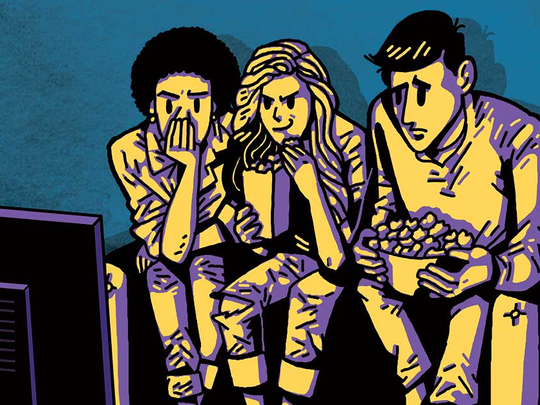
On paper, Riverdale and 13 Reasons Why are nothing alike. On one hand, Riverdale is a slick and stylised adaptation of Archie Comics, where a small town high school has to reckon with the death of their star water polo player (Season 1) and a serial killer on the loose (Season 2). On the other, 13 Reasons Why is a starkly realistic take on a high school student who commits suicide and leaves cassette tapes detailing why (Season 1) and the subsequent court case to determine the school’s liability (Season 2).
But the teen mystery TV shows have something in common: they both deal with hot-button issues impacting young people today — and neither of them get it exactly right.
Since the Season 2 premiere of 13 Reasons Why last week, it’s been slammed by critics. Calls for cancellation have been renewed. Some are traumatised by the unambiguous depiction of suicide in Season 1, and others are outraged by the detailed rape scene (one of many on the show) in the finale of Season 2.
The polarising season deals primarily with mental health and sexual violence. It explores the grotesque extent of the ‘locker room culture’ that can become a fertile breeding ground for sexual assault. Bryce Walker, co-captain of Liberty High School’s baseball team, is a shameless predator, assaulting girls and documenting the evidence with a Polaroid camera. His teammates cover up for him. The courts forgive him. Stigma plagues his victims. It’s a painfully familiar story. Through Bryce, we see the Brock Turners of the world reflected back at us — something that actor Justin Prentice confirmed was intentional.
Nudity, language and violence (particularly sexual violence) are all used to tell this story. The graphic nature of the series is possible because it airs on a subscription-based streaming service, so there’s less red tape (or advertisers) to reckon with. The TV-MA rating is something we’ve seen with cable shows like Game of Thrones on HBO, which has received its fair share of flak (though no calls for cancellation), but it’s different when you’re telling teens that a show riddled with extreme content is intended for them.
As their rebuttal, showrunners claim they want to start a conversation. But their methodologies are flawed. The show succeeds off the back of its stellar ensemble cast and its poignant portrayal of friendship, family and human relationships. It starts a conversation just by naming the problem. But it muddles that same conversation by exploiting the problem with overly explicit portrayals. (The show has other issues, of course; it presents a flawed equivalency between a suicidal teen and a homicidal one, and turns Hannah Baker into even more of a Manic Pixie Dream Girl as she becomes a figment of Clay Jensen’s imagination.)
Understandably, there are people who are disturbed by 13 Reasons Why. There are also people who feel relieved, empowered or even vindicated as they watch this mismatched group of young teens band together against the evils of society. But the latter does not negate the former. And it reminds us that bold storytelling, with a little more care in the writing and editing rooms, doesn’t have to be harmful to its viewers.
Riverdale has never claimed to want spark social change, though it can’t help itself from skirting around some of the same issues that 13 Reasons Why deals with. But its exaggerated tone, from peculiar dialogue to old-fashioned outfits, doesn’t lend itself well to tackling real world issues. In the background of its over-the-top murder mystery, we see heavy-handed and out-of-place subplots that attempt to scratch the surface of more serious issues. There’s the ‘playbook’ that includes names of girls guys have hooked up with, the ‘sticky maple’ scene, followed by the hot tub revenge scene, that hints at the impact of cyberbullying, an episode on ethical journalism and even a scene where Josie schools Archie on how much harder women of colour have to work to get their skills noticed.
The show’s heart is in the right place, and they should be encouraged to tackle major issues that often get swept under the table. But most of these moments feel hollow, forced into the narrative and immediately forgotten, rather than woven thoughtfully and organically throughout.
At a time when bullying, mental health struggles, sexual assault and gun violence are all issues occurring at an alarming frequency, content creators are tasked with finding a way to connect with viewers without exploiting them, undermining them or adding figurative fuel to the fire. If you’re asking young people to dive head-first into tough subject matters, authenticity is important, but so is figuring out how to cushion the fall.
As 13 Reasons Why continues to grapple with balancing responsible and hard-hitting storytelling, possibly on its way to a third season — and as Riverdale tries to balance the ludicrous with the sincere — there’s perhaps room somewhere in the middle for a more well-thought out exploration of teenagehood in the 21st century.
Not every show has to be perfect, nor does it have to be escapist. The best TV shows can, and should, point to society’s failings. They can, and should, expose its most vulnerable wounds. But to the best of their abilities, they should try to never rip those wounds further open.










